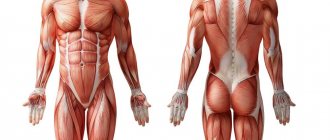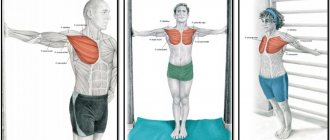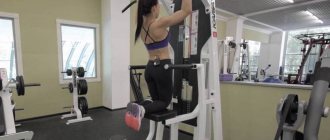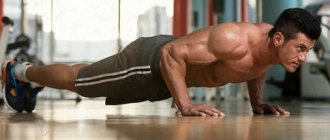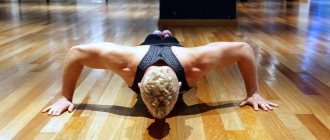Home / About the problem / How to cope with the consequences of muscle strain?
Injuries
Almost every one of us knows the feeling of pain that occurs a day after intense training or unusual physical work. It’s worth doing exercises in the gym for an undeveloped muscle group or working hard in the spring at the dacha - and in the morning everything in your body aches. Doctors call this condition delayed onset muscle pain syndrome (DSMS) or sore throat, and in everyday life we often say that “muscles are clogged.”
What is progressive overload?
The best way to explain this is to tell you a very important secret.
You see, the body doesn't care that you train for specific goals. He doesn't care if you want to build muscle, burn fat, tone, get stronger, improve performance, or just look great naked.
The body only cares about keeping you alive and functioning as efficiently as possible. This is his only real goal.
Your body is smart and capable enough to perform these tasks and does what it needs to adapt to its environment.
And this feature is the main goal that you should strive for in the training process.
I mean that the body will change and progress only if conditions are created in which these processes simply MUST happen.
Or in other words, your body will not change and progress unless you force it to do so.
No matter how perfect your training program is, muscle will not grow, strength will not increase, and performance will not improve unless you give your body obstacles that it NEEDS to overcome.
And this brings us to what is called the principle of progressive overload.
Mental and muscle tension
Our world is becoming more and more unstable, so it is not surprising that there is an increase in diseases developing against the background of neuropsychiatric disorders and emotional breakdowns. Which in turn leads to involuntary bursts of muscle activity - pathological muscle tension. Other factors that provoke hypertonicity include hypothermia or injury.
What is muscle tension?
Muscle tension is a localized surge in muscle activity that occurs against the background of external and internal influences. It can be situational or chronic.
The disease can be triggered by mechanical overload, a psychological or neurological factor, which triggers a subconscious reflex reaction. For example, sudden fear, which forces you to involuntarily perform various actions: holding your breath, tensing various muscle groups and other similar manifestations.
Dependence on neuroses and emotional arousal
Muscle tension due to neuroses or neurasthenia manifests itself in severe pain that requires special treatment. With neuroses, tension in muscle tissue is provoked by:
- Fear is a premonition in which a person is in a state of anticipation for a long period of time for something that can cause pain or create other unpleasant moments.
- Exhaustive physical activity, which results in constant muscle spasms. It manifests itself in spontaneous contraction of various muscle groups, in which twitching and other similar manifestations are observed.
Muscle tension against the background of emotional reactions manifests itself under the following factors:
- Sleep disturbances, insomnia.
- Increased sensitivity to emotional overload.
- Feeling of constant anxiety.
- An emotional upsurge that causes a muscle group to be in increased tone.
- Decreased sexual activity.
Muscle tension syndrome
Frequent spasms of muscle tissue inhibit their work and create conditions for the development of unpleasant diseases. The syndrome occurs reflexively, and the causative diseases are neurological in nature. Including failures of the central nervous system of a genetic nature, chronic injuries or the influence of secondary factors.
The pathology of the syndrome is manifested by compaction, contraction, and shortening of muscle fibers. Muscle tone is characterized by two types:
- Diffuse. Not all muscle tissues are involved in the process of change, but only part of them. Partial pathology is observed.
- Generalized. All areas of muscle tissue, extensors and flexors, are involved in the process of damage by the syndrome.
Muscle tension syndrome is also divided into moderate and severe:
- With moderate damage, the muscles are persistently painful.
- When severely expressed, the tissues are unusually dense and cause extraordinary pain when palpated, which only intensifies with massage and heating.
Tension headaches do not cause nausea and vomiting, but they do cause other symptoms. These include: increased sensitivity to loud, sharp sounds, aversion to bright light, irritability, nervousness, weakness, etc.
- Tension headache
The principle of progressive overload
At its core, the principle of progressive overload states:
| In order for muscles to grow, strength to increase, performance to increase, and any similar progress to occur, the body must be forced to adapt to loads greater than those it has previously experienced. |
Go back and read this again. This is really important.
This means that if you lift the same weight, the same rep range, the same way for the next 20 years, nothing will ever happen.
You will only maintain the existing state of affairs.
However, if you increase the stress on the body by increasing the weight, increasing the number of repetitions, or simply creating conditions that will place demands on the body beyond its current capabilities, then the body will have no choice but to make the necessary changes and improvements that will allow it to adapt. to these conditions and remain capable of performing these tasks.
The result of these “changes”, “improvements” and “adaptations” will be increased muscle , strength and tone , loss of fat , improved performance and just the overall results you want to get.
All of these goals can be achieved by performing exercises that force our body to adapt to stress.
Essentially, you are simply showing your body that in order to withstand the stress you are putting on it, it NEEDS to change and improve.
Let me show with a concrete example exactly what I mean.
Treating Overtraining
First aid, which is aimed at treating an athlete’s overtraining:
- Give your body a few extra days of rest between workouts (2-3 days).
- Change the training program to an easier (simple) one, or reduce the working weights in the exercises by 30-40% , that is, if your bench press on a horizontal bench, for example, was 100 kg in 4 sets of 8 repetitions, then taking into account the reduction the load will be 60-70 kg .
Often, these two simple tips to regain strength. However, in order to comprehensively solve the problem of overtraining, it is necessary to include a full arsenal of recovery measures that can and should be used by any athlete whenever possible:
- We increase the additional break in training from 2-3 days to 1-2 weeks
- Reducing training load, working with very light weights ( 50% lower !)
- Increased sleep (up to 10 hours)
- Improving the quality of nutrition, consumption of adaptogens, sports nutrition, vitamin and mineral complexes
- Regular muscle massage
- Avoidance of work associated with excessively nervous and energy-consuming activities
Muscle growth directly depends on the nervous system ; it cannot be overstrained by large volumes of training, heavy weights and daily stress.
Treatment of overtraining will be considered complete if you again have motivation, a desire to train, and progress. In practice, overtraining is considered cured when you begin to make gains in strength and mass again.
Treating Overtraining
Example of progressive overload
Let's imagine that you are now able to lift 20 kg in any exercise in 3 sets of 8 repetitions.
If you continue to lift those 20kg for the same 3 sets of 8 reps for the next 20 years then...you WILL NOT increase muscle mass or strength. Why? Because there was no progressive overload.
Your body has already adapted to this load (20 kg for 3 sets of 8 reps) and has provided you with the muscle volume and strength needed to perform this task on a regular basis.
Without increasing the load on your body, you are not giving it the SMALLEST reason to develop further.
You can do everything else great, but if you can't progressively overload your body over time, it will never change.
However, if you were to lift 20kg for 3 sets of 9 reps (instead of 8) on the same exercise, then there would be room for improvement.
Why? Simply because you increased the load. You have increased the demands placed on the body, as well as the amount of work it must do. Instead of doing the same 3 sets of 8 reps with 20kg, you put in the effort to do 1 extra rep on each set.
And while the progress may seem small, this is EXACTLY what you need to do for your body to improve.
Likewise, if you were to now try to lift 25kg (instead of 20kg) for 3 sets of 8 reps, the exact same stimulus would be generated.
Essentially, you are telling your body, “Look at this. The amount of work you have to do has increased, so you need to increase your muscles and strength to do it."
Symptoms and signs of overtraining
The main task of an athlete, of any level of training, is not to fall into overtraining, to identify the symptoms of its development at the initial stage and respond to them in a timely manner.
Below are the distinctive signs that signal to a person that his body is most likely approaching the limit of its capabilities:
- Stopping the growth of strength and muscle mass
- Loss of strength, loss of mass and muscle definition
- Chronic fatigue of the body
- Lack of desire to exercise, loss of motivation
- Development of unreasonable aggression, excessive irritability and depression
- Constant aching pain in muscles, ligaments, joints
- Decreased immunity
- Lack of appetite and libido
- Headaches, sleep disturbances
- Disorders of the cardiovascular system and menstrual cycle
Many, even experienced athletes, cannot react in time to the symptoms of overtraining; as a result, it develops into chronic overtraining, as a result of which the athlete’s career is jeopardized.
Symptoms and signs of overtraining
The chronic form of overtraining is one of the most dangerous, and requires the immediate adoption of decisive actions, aimed primarily at quickly eliminating the factors that caused it.
This is progressive overload
It doesn't matter if you do 1 more rep per set or add 5kg of weight on each set. Your goal is to do more than you did before.
As long as you do this as often as you can and ensure that gradual progress continues to take place over time, your body is capable of changing and improving.
As long as these reasons are present, you are guaranteed results.
At the same time, as soon as these bases disappear, the body ceases to have an incentive to progress. No matter how well you do everything else, there will be no positive results if there is no progressive overload.
What to do if severe pain does strike
There is a lot of useful advice above, but a person is designed in such a way that he often begins to move after he has done something. Roughly speaking, when “ a roast rooster pecked in the ass .” Well, the sore throat is blooming and blooming and we need to do something about it, otherwise the white light is not nice.
The simplest option is to lightly warm up those muscles that are severely sore. But it is the WARM-UP, not their load. The muscles are already injured, why stress them even more. Let's say your pecs hurt like crazy - move your arms forward 10-20 times in 3-4 approaches, gently tensing the muscles at the end of the movement. If your legs are groaning , you can do 10-15 squats in 3-4 approaches or go for an intense walk. The point is to pump blood into the muscles, which will bring useful substances for their restoration and wash away decay products.
A more difficult option is massage or self-massage. Finding a good sports massage therapist is a big problem, but if you have found one, hold on to him with your hands and feet. During a high-quality sports massage, of course, you will howl and squeak, but 30–40 minutes of unpleasant sensations are worth a couple of days of suffering from muscle pain. In addition, such a massage removes excess tone from the muscles and generally has a positive effect on their recovery.
If you don’t have a specialist or the money for one, then it’s worth spending once on a high-quality massage cylinder , which allows you to do self-massage using your own body weight.
A very affordable and useful option is a bathhouse or sauna . I use it very actively myself. Warming up the muscles acts in much the same way as their diligent warm-up, as well as massage - blood circulation improves, useful substances come in, and breakdown products are eliminated.
Alternatively, take a hot bath . No more than 10–15 minutes, otherwise you might turn into a vegetable for a while. The effect is not so noticeable, but it is also there.
In very extreme cases, apply ice packs to the sore muscles, or even dive into an ice bath, if one is available.
The main reason for failure
Lack of progressive overload is the main reason why most people don't make progress and look the same over time as they did when they started strength training.
This is a sad sight that can be seen in every gym.
Men, women, youth, older people, fat, thin... They do nothing to increase the load on their body. Therefore, he has no choice but to remain the same.
This is great if that's your goal. If you already have a great body that looks exactly the way you like. There is no room for progressive overload here as you just want to maintain the current state.
But until you reach that point, your focus should be on progressive overload.
Pain varies
Those who go to work out know that there are two types of pain: the burning of muscles during an intense workout and the pain that occurs the day after visiting the gym. In the first case, the pain is associated with the production of lactic acid. The latter occurs in the body when the muscles lack oxygen due to intense exercise.
“Lactic acid acts as a kind of intermediate product, a mediator in energy processes: it is easier for the body to use it than glucose. If the workout is very intense, then the level of lactic acid production increases, and it has the property of splitting off hydrogen ions. It is he who “burns” your muscles,” Rzhevtseva explained.
According to the expert, the pain that appears the next day is more likely due to damage to muscle fibers during training and their inflammation.
Article on the topic
Go to the gym with a smile. What is smart fitness?
Do you need to progress with every workout?
No. In fact, it is almost impossible to do this, at least for a significant period of time. If we could do this, we would be lifting millions of pounds for millions of repetitions of each exercise. But this is simply unrealistic.
However, we must not forget about progress and try to increase the load as often as possible (without forgetting about safety and correct technique, of course).
Whether this happens every workout, every other workout, once a month, or less often depends on a huge number of factors specific to you and your goals.
However, your #1 job is to ensure that this is the case.
As long as progressive overload is consistently present in your training, you will build muscle, increase strength, improve tone or whatever else you are working on.
Cold and hot shower
A contrast shower relieves pain after training (Photo: www.pexels.com)
Immediately after exercise, take a massage contrast shower. For 10-20 minutes, run the shower under pressure over the painful areas, changing the temperature of the water. Start with warm and gradually switch to cold. It is not recommended to suddenly change the temperature from hot to ice.
Include in your diet foods containing calcium and potassium - elements responsible for muscle contraction. To replenish minerals in your body, drink mineral water containing these elements after your workout.
Conclusion
So, if you skipped to this chapter because you were too lazy to read the whole article, here is the main takeaway.
If you want to get positive results from your training, progressive overload is a key factor in the process.
It doesn't matter who you are, what your goals are, or what type of workouts and exercises you do. If you want results, you must make sure that progressive overload takes place in your training.
If you don't have it, you are guaranteed to fail. If it is present, you will definitely achieve success. Everything is very simple.
Massage for muscle strain
An obligatory component of complex therapy, how to relieve tension in the body during neurosis, is one of the massage techniques. The main movements are soft, stroking pressure. Tapping and pinching are unacceptable. It is recommended to perform the procedures in specialized rooms, where an experienced specialist, even with a cursory examination, will identify tense muscle areas - blocks.
Objectives of massage:
- reduce the influence of the autonomic nervous system;
- restore the patient’s psycho-emotional state;
- improve sleep;
- relieve hypertonicity of muscle groups;
- restore metabolic processes in tissues;
- increase lymph flow and blood circulation.
However, massage for neurosis is not always possible. Absolute contraindications are hyperthermia or severe psycho-emotional disorder with hysteria.
At home, it is permissible to perform self-massage - use soft stroking and pressure to knead the tense muscles of the back of the head, neck, face, and limbs. This will reduce the negative impact of stress and restore the emotional background. Whereas to relax your back muscles, it is better to use the services of a professional massage therapist.




